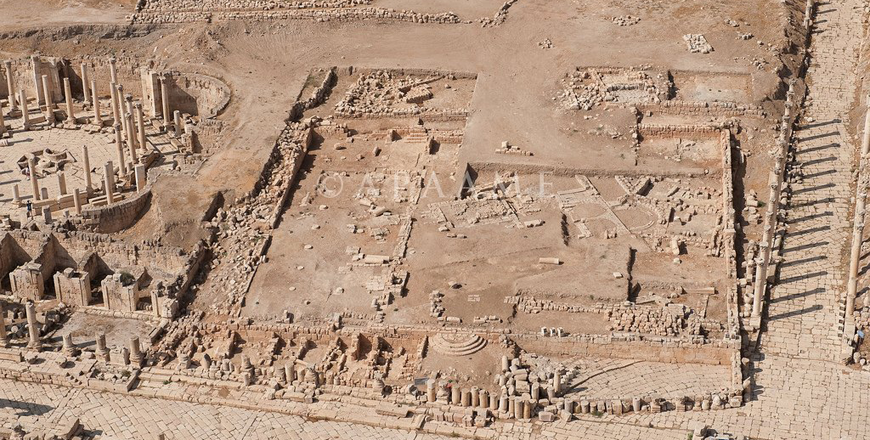You are here
Ancient Gerasa: Studying central bathhouse’s use through the ages
By Saeb Rawashdeh - Mar 02,2024 - Last updated at Mar 02,2024

The aerial view of Ummayyad congregational mosque in Gerasa (Photo courtesy of APAAME)
AMMAN — Built in the late 3rd or early 4th century AD, the Central Bathhouse in Gerasa (modern Jerash) was in use for another 300 years.
“We cannot say for sure who built it [we do not have any inscriptions that tell us], but it was most likely paid for by members of the local elite of Jerash,” noted senior lecturer from the University of Edinburgh, Louise Blanke, in a recent e-mail interview with The Jordan Times.
Blanke is an archaeologist that was trained by the University of Copenhagen, where she completed her Bachelor and Master’s degrees, as well as her PhD. Later, Blanke held postdoctoral positions in Aarhus (Denmark), Oxford and Cambridge (UK) and in 2019, she joined the University of Edinburgh in Scotland.
Specialised in the late Antique and Islamic periods, she has worked for nearly 20 years in Jerash with the scholar Alan Walmsley on the “Danish-Jordanian Islamic Jerash Project” where she was responsible for the excavation of the Central Bath house and since 2015, she is working on a new project that examines a residential area and its development throughout Jerash’s history with a particular interest in the Umayyad and Abbasid periods.
The Central Bathhouse was renovated and repaired multiple times in the period between circa 400AD and 700AD.
“During this time, it saw five main architectural phases,” Blanke said, adding that “During the span of the bathhouse’s long usage, we see repairs to the hypocaust system [the underground heating] and in one case a full replacement of the room’s architectural furnishing”. Other changes included the disuse of some heated rooms — the floors were lifted and the hypocaust space below was filled in, Blanke continued, noting that in the long run,“ we see a change from communal bathing in larger basins towards individual bathing in small bathtubs.”
At the end of the bathhouse’s lifespan, it was equipped with a few individual bathtubs in the heated section and a single basin in the unheated section, Blanke said, noting that “The bathhouse’s communal latrine [toilet] continued to function throughout the building’s history”.
Towards the end of the bathhouse’s history, it had fallen into a state of disrepair and was only a fraction of its original size and usage, Blanke highlighted, adding that “It is possible that it was even closed for a period before it was demolished”.
“In the early Islamic period, the Umayyad rulers wished to find a central location for the construction of a congregational mosque and so the building that stood at the intersection of the city’s two main thoroughfares [the Central Bathhouse] was dismantled to make room for the construction of the mosque,” Blanke underlined.
Related Articles
AMMAN — During the Late Roman, Byzantine and Umayyad times, Gerasa (modern Jerash) was famous for its bathhouses.This time, we are going to
AMMAN — Plagues, wars and earthquakes shaped the history of urban centres and states.
ALEPPO, Syria — The ancient bathhouses of Syria’s second city Aleppo are filling up again, not because of a revived fad, but due to power cu

















